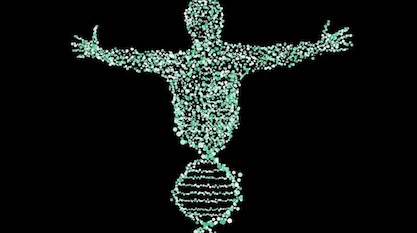 Human Origins
Human Origins
Mitochondrial Eve and Y-Chromosome Adam, and Adam and the Genome


In his book Adam and the Genome, which we’ve been reviewing, biologist Dennis Venema devotes nearly three pages to discussing Mitochondrial Eve and Y-Chromosome Adam. As we’ve seen, though, many topics covered in the slim volume have little bearing on the existence of the Adam and Eve as the progenitors of modern humans. And so it is here.
For reasons that have to do with population genetics, both evolutionists and Darwin-skeptics believe that all living humans trace back to a common female ancestor, and a common male ancestor. As regards the “biblical” Adam and Eve, the question is whether these two lived at the same time and could have been a couple that was the progenitor of the genomes of all members of the entire human race, or whether they lived at different times and places and only passed on their mitochondrial DNA and Y chromosomes to us while a much larger chrono-population gave rise to our non-sex chromosomes (autosomes).
In his section on Mitochondrial Eve and Y-Chromosome Adam, Venema doesn’t spend much time addressing that question. His main point is that that the existence of Mitochondrial Eve and Y-Chromosome Adam don’t necessarily imply the biblical “Adam and Eve.” That’s a fair point, and it’s one that ID proponents have also made in the past. See, for example, “About ‘Y Chromosome Adam’ and ‘Mitochondrial Eve’.”
But it’s also worth pointing out that it is not impossible that Mitochondrial Eve and Y-Chromosome Adam were in fact the traditional Adam and Eve. Darwin-skeptics Fazale Rana and Hugh Ross of Reasons to Believe (RTB), an old-earth creationist organization, think they could have lived concurrently. They write in their book Who Was Adam?:
Corrections to mitochondrial-DNA mutation rates that factor in heteroplasmy place mitochondrial Eve perhaps as recently as 50,000 years ago — squarely within the range predicted by the RTB model (between 10,000 and 100,000 years ago)….
These later studies used much more expansive regions of the Y chromosome. Their findings indicate that humanity’s male lineage originated around 40,000 to 60,000 years ago. They also verify that humanity’s origin traces to one location and to a small population. The results fall in line with yet another study that placed humanity’s origin between 35,000 and 47,000 years ago.
As with the studies on genetic diversity and mitochondrial DNA, Y-chromosome analysis of humanity’s history fully concurs with predictions made by RTB’s model for humanity’s origin.
(Who Was Adam?, pp. 64, 66)
Of course, it’s hard to make definitive arguments on these questions because they rely on molecular clock dating estimates, which are notoriously imprecise and unreliable. The topic is interesting, to be sure. But directly relevant to the subject of Venema’s book? Not so much.
Image credit: NeuPaddy, via Pixabay.
